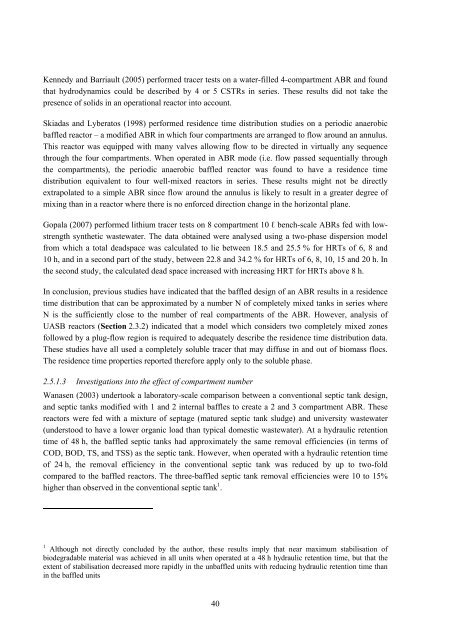analysis of a pilot-scale anaerobic baffled reactor treating domestic ...
analysis of a pilot-scale anaerobic baffled reactor treating domestic ...
analysis of a pilot-scale anaerobic baffled reactor treating domestic ...
Create successful ePaper yourself
Turn your PDF publications into a flip-book with our unique Google optimized e-Paper software.
Kennedy and Barriault (2005) performed tracer tests on a water-filled 4-compartment ABR and found<br />
that hydrodynamics could be described by 4 or 5 CSTRs in series. These results did not take the<br />
presence <strong>of</strong> solids in an operational <strong>reactor</strong> into account.<br />
Skiadas and Lyberatos (1998) performed residence time distribution studies on a periodic <strong>anaerobic</strong><br />
<strong>baffled</strong> <strong>reactor</strong> – a modified ABR in which four compartments are arranged to flow around an annulus.<br />
This <strong>reactor</strong> was equipped with many valves allowing flow to be directed in virtually any sequence<br />
through the four compartments. When operated in ABR mode (i.e. flow passed sequentially through<br />
the compartments), the periodic <strong>anaerobic</strong> <strong>baffled</strong> <strong>reactor</strong> was found to have a residence time<br />
distribution equivalent to four well-mixed <strong>reactor</strong>s in series. These results might not be directly<br />
extrapolated to a simple ABR since flow around the annulus is likely to result in a greater degree <strong>of</strong><br />
mixing than in a <strong>reactor</strong> where there is no enforced direction change in the horizontal plane.<br />
Gopala (2007) performed lithium tracer tests on 8 compartment 10 ℓ bench-<strong>scale</strong> ABRs fed with lowstrength<br />
synthetic wastewater. The data obtained were analysed using a two-phase dispersion model<br />
from which a total deadspace was calculated to lie between 18.5 and 25.5 % for HRTs <strong>of</strong> 6, 8 and<br />
10 h, and in a second part <strong>of</strong> the study, between 22.8 and 34.2 % for HRTs <strong>of</strong> 6, 8, 10, 15 and 20 h. In<br />
the second study, the calculated dead space increased with increasing HRT for HRTs above 8 h.<br />
In conclusion, previous studies have indicated that the <strong>baffled</strong> design <strong>of</strong> an ABR results in a residence<br />
time distribution that can be approximated by a number N <strong>of</strong> completely mixed tanks in series where<br />
N is the sufficiently close to the number <strong>of</strong> real compartments <strong>of</strong> the ABR. However, <strong>analysis</strong> <strong>of</strong><br />
UASB <strong>reactor</strong>s (Section 2.3.2) indicated that a model which considers two completely mixed zones<br />
followed by a plug-flow region is required to adequately describe the residence time distribution data.<br />
These studies have all used a completely soluble tracer that may diffuse in and out <strong>of</strong> biomass flocs.<br />
The residence time properties reported therefore apply only to the soluble phase.<br />
2.5.1.3 Investigations into the effect <strong>of</strong> compartment number<br />
Wanasen (2003) undertook a laboratory-<strong>scale</strong> comparison between a conventional septic tank design,<br />
and septic tanks modified with 1 and 2 internal baffles to create a 2 and 3 compartment ABR. These<br />
<strong>reactor</strong>s were fed with a mixture <strong>of</strong> septage (matured septic tank sludge) and university wastewater<br />
(understood to have a lower organic load than typical <strong>domestic</strong> wastewater). At a hydraulic retention<br />
time <strong>of</strong> 48 h, the <strong>baffled</strong> septic tanks had approximately the same removal efficiencies (in terms <strong>of</strong><br />
COD, BOD, TS, and TSS) as the septic tank. However, when operated with a hydraulic retention time<br />
<strong>of</strong> 24 h, the removal efficiency in the conventional septic tank was reduced by up to two-fold<br />
compared to the <strong>baffled</strong> <strong>reactor</strong>s. The three-<strong>baffled</strong> septic tank removal efficiencies were 10 to 15%<br />
higher than observed in the conventional septic tank 1 .<br />
1 Although not directly concluded by the author, these results imply that near maximum stabilisation <strong>of</strong><br />
biodegradable material was achieved in all units when operated at a 48 h hydraulic retention time, but that the<br />
extent <strong>of</strong> stabilisation decreased more rapidly in the un<strong>baffled</strong> units with reducing hydraulic retention time than<br />
in the <strong>baffled</strong> units<br />
40
















